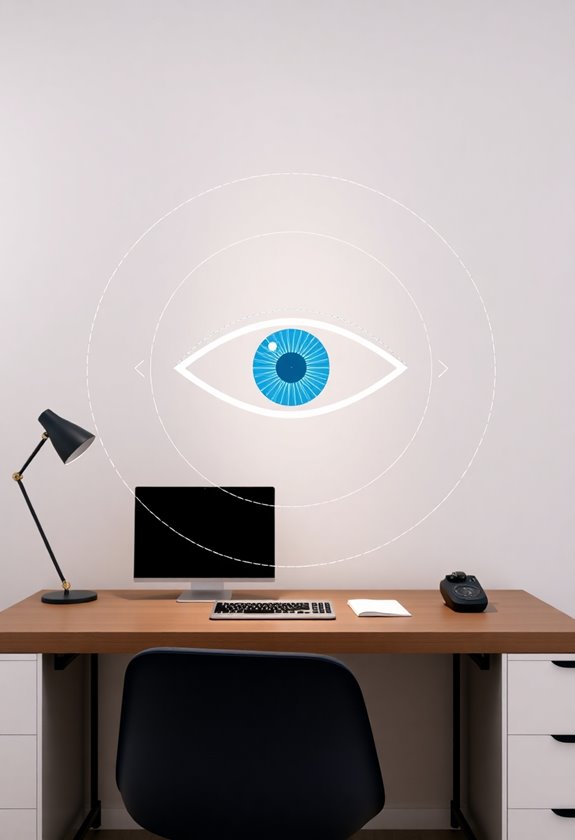You'll protect your eyes during computer work with these proven relief methods. Practice the 20-20-20 rule by looking at something 20 feet away every 20 minutes for 20 seconds. Soothe tired eyes through palming, where you place warm hands over closed eyes for 30 seconds. Build eye muscle strength by alternating focus between near and far objects, and perform gentle circular eye rolls hourly. Try figure-eight movements to enhance flexibility, consciously blink often, and regularly gaze out windows to reduce strain. These evidence-based techniques will help maintain your long-term eye health as you discover additional strategies.
Highlights
- Follow the 20-20-20 rule by taking regular breaks every 20 minutes to focus on distant objects for eye muscle relaxation.
- Practice palming by covering closed eyes with warm hands for 30 seconds to soothe eye strain and promote relaxation.
- Strengthen eye muscles through near-far focus exercises, alternating between close objects and distant targets every 20 minutes.
- Perform gentle circular eye rolls in both directions to lubricate eyes and reduce fatigue during extended computer sessions.
- Use figure-eight eye movements to improve eye muscle flexibility and reduce strain while maintaining natural head position.
The 20-20-20 Rule

Every eye care professional recommends the 20-20-20 rule as the essential practice for reducing digital eye strain. This simple but effective technique helps prevent eye fatigue and maintains your visual comfort throughout the workday.
Here's how to apply the 20-20-20 rule:
- Every 20 minutes, take a break from looking at your screen
- Focus on something that's at least 20 feet away from you
- Keep your gaze on that distant object for at least 20 seconds
You'll find this method particularly effective because it allows your eye muscles to relax and reset after periods of intense focus. While you're following the 20-second break, try to blink several times to help lubricate your eyes, and you might want to set a timer on your computer to remind you when it's time for your next eye break.
Palm Your Eyes

Palming provides a soothing break for tired eyes during long computer sessions. To perform this technique, start by rubbing your hands together vigorously until they feel warm, which increases blood flow and creates healing energy in your palms. Next, place your cupped palms gently over your closed eyes, making sure you're not applying pressure to your eyeballs while keeping out all light.
Maintain this position for 30 seconds to 2 minutes while taking slow, deep breaths and letting your eye muscles completely relax. You'll want to rest your elbows on your desk to keep your arms from getting tired during the exercise. When you're done, slowly remove your hands and gradually open your eyes, allowing them to readjust to the light before returning to your computer work.
Focus Near and Far

Another effective eye exercise for digital eye strain is the focus shifting technique, which helps strengthen eye muscles and maintains their flexibility. Here's how to perform this exercise correctly:
- Hold your thumb about 10 inches from your face and focus on it intently for 5 seconds.
- Without moving your head, shift your gaze to an object that's at least 20 feet away, focusing on it for another 5 seconds.
- Return your focus to your thumb, then back to the distant object, repeating this pattern 10 times.
You'll want to perform this exercise every 20 minutes during your computer work to maintain healthy eye function and reduce strain on your focusing muscles, which can become fatigued during extended screen time.
Circular Eye Rolling

Rolling your eyes in gentle, circular motions is one of the most soothing exercises for tired eyes during computer work. This technique helps lubricate your eyes while relaxing the muscles that become strained during long hours of screen time.
Here's how to perform circular eye rolling correctly:
- Sit up straight and focus on a point directly ahead of you
- Slowly roll your eyes clockwise in a complete circle, taking about 3 seconds per rotation
- Complete 5 clockwise circles, then pause for 2 seconds
- Switch direction and perform 5 counterclockwise circles
- Blink naturally throughout the exercise
You'll want to do this exercise every hour during computer work, and you can repeat it up to three times in each session for maximum benefit.
Figure Eight Eye Movement

Drawing a figure eight pattern with your eyes helps strengthen the extraocular muscles and improves their flexibility during long computer sessions. You'll want to imagine a large horizontal figure eight about three feet in front of your face while keeping your head still and steady.
Begin by looking at the center point of your imaginary figure eight, then slowly trace the pattern with your eyes in one direction for 30 seconds. Next, reverse the movement and trace the pattern in the opposite direction, maintaining a smooth, controlled motion throughout the exercise. While performing this movement, you should feel a gentle stretch in your eye muscles, but if you experience any discomfort, slow down or take a brief pause.
Window Distance Gazing

The simple act of looking through a window can provide essential relief for tired eyes during computer work. You'll want to perform this exercise every 20-30 minutes throughout your workday to help prevent digital eye strain and maintain healthy vision.
Here's how to perform window distance gazing effectively:
- Find a window with a clear view of distant objects, preferably 20 feet or more away
- Gently shift your gaze from your screen to focus on something in the distance
- Hold your focus on the distant object for 20 seconds, allowing your eye muscles to relax
- Slowly return your gaze to an object about 10 feet away for 10 seconds
- Finally, bring your attention back to your screen while maintaining a relaxed posture
Conscious Blinking Exercise

Frequent computer use often leads to reduced blinking rates, causing dry and irritated eyes. When you're focused on your screen, you might blink only 3-4 times per minute instead of the normal 15-20 times, which can result in significant eye strain and discomfort.
To combat this issue, practice conscious blinking exercises throughout your workday:
- Set a timer to remind you every 20 minutes to perform 10 complete blinks
- Make each blink deliberate and complete, ensuring your upper and lower eyelids fully connect
- Hold each blink for a moment longer than usual to help spread tear film across your eyes
You'll notice immediate relief as these exercises help redistribute your natural tears, keeping your eyes properly lubricated and reducing the burning sensation that often accompanies extended screen time.
Frequently Asked Questions
Can Eye Exercises Permanently Improve My Vision or Prevent the Need for Glasses?
Eye exercises can't permanently improve your vision or eliminate the need for glasses, as they don't change your eye's physical structure or correct refractive errors. While exercises may temporarily relieve eye strain and help your eye muscles work more efficiently, they won't fix underlying vision problems like nearsightedness, farsightedness, or astigmatism that require corrective lenses for proper visual acuity.
How Long Should I Wait After Eye Surgery Before Doing These Exercises?
You'll need to wait for your doctor's specific approval before starting any eye exercises after surgery, as recovery times vary by procedure. Most ophthalmologists recommend waiting at least 2-4 weeks after LASIK or cataract surgery before resuming gentle eye movements, while more complex surgeries may require 6-8 weeks of rest. Don't start exercises without first consulting your eye surgeon for personalized guidance based on your healing progress.
Are Eye Exercises Safe to Perform While Wearing Contact Lenses?
You can safely perform most eye exercises while wearing contact lenses, but you'll need to be gentler and more mindful of your movements. Don't rub your eyes or do exercises that might dislodge your contacts. Simple exercises like blinking, focusing on distant objects, and gentle eye rolls are perfectly safe with contacts, but if you experience any discomfort or dryness, remove your lenses first.
Can Children Benefit From These Eye Exercises While Doing Online Schoolwork?
Want to help your child maintain healthy eyes during their virtual learning sessions? Eye exercises can absolutely benefit children during online schoolwork, as they help reduce digital eye strain and prevent fatigue. You'll want to teach your kids to follow the 20-20-20 rule: looking at something 20 feet away for 20 seconds every 20 minutes. These exercises can improve their focus, reduce headaches, and make screen time more comfortable.
What Underlying Eye Conditions Might Make These Exercises Potentially Harmful?
You shouldn't perform eye exercises if you have acute eye infections, recent eye surgery, or severe conditions like retinal detachment or advanced glaucoma. If you're experiencing sharp eye pain, inflammation, or diagnosed with strabismus (crossed eyes), these exercises might worsen your condition. It's crucial to consult your eye doctor before starting any eye exercise routine, especially if you have pre-existing eye conditions or have undergone recent ocular procedures.




